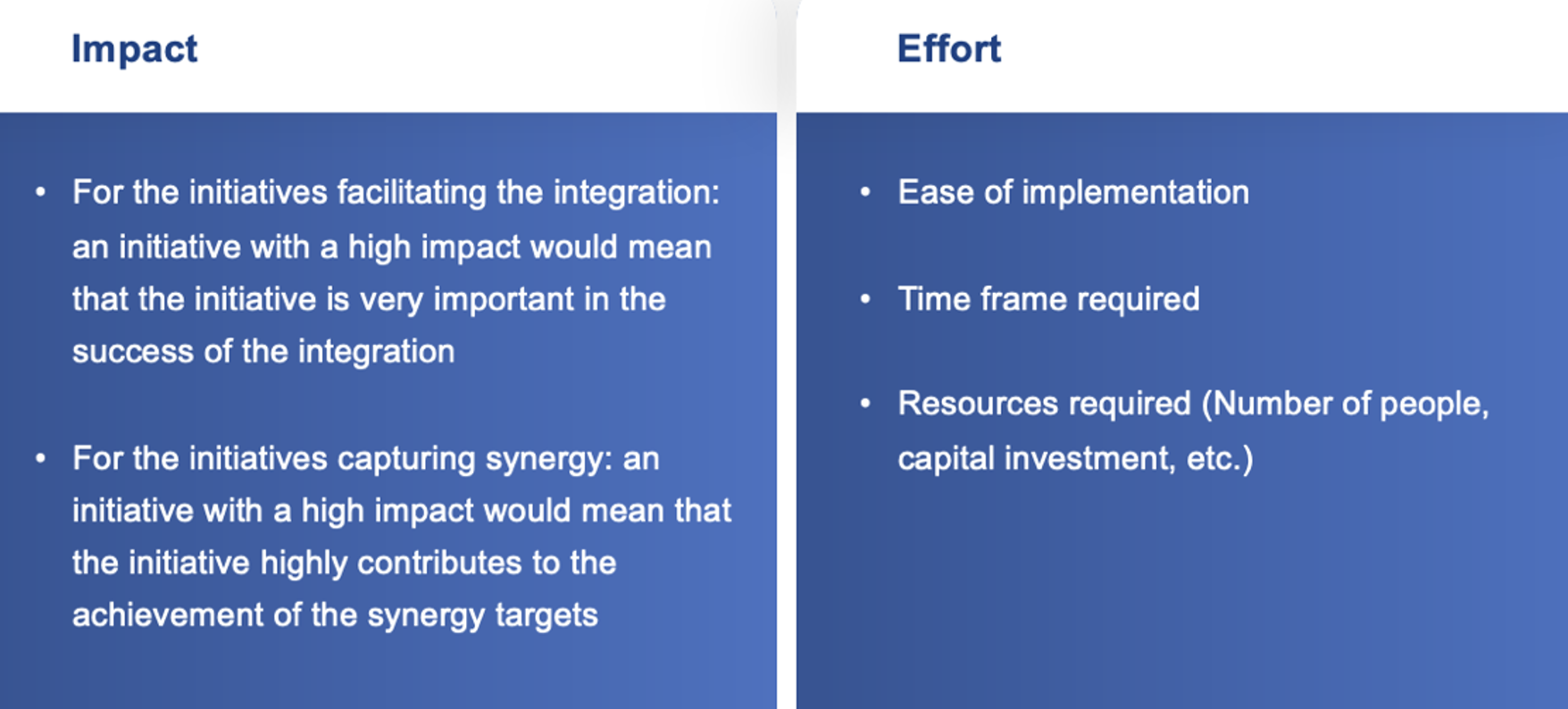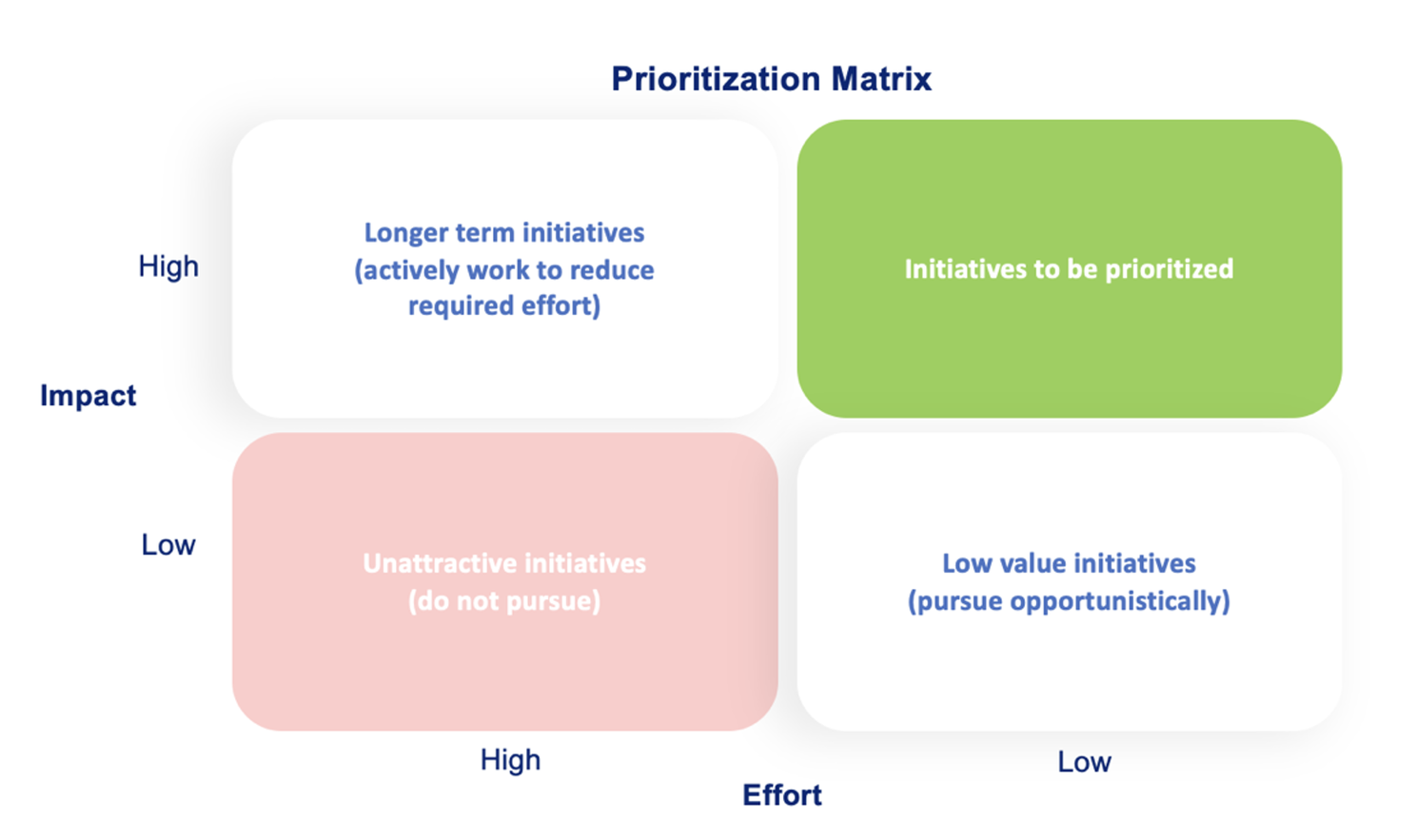Navigating the complex landscape of mergers and acquisitions requires robust strategy and efficient decision-making tools. One such tool that can bring clarity and alignment to the process is the Impact versus Effort Matrix.
The Context: Pre-deal, M&A Programme Design and Pre-Integration Planning Workshops
The use of the Impact versus Effort Matrix proves particularly beneficial in the pre-deal phase of a merger or acquisition. This stage involves a series of programme design and pre-integration planning workshops, where various stakeholders come together to outline the path forward.
The participants in this stage typically include key figures such as the Head of M&A or Corporate Development, Head of Strategy, CFO and the leads of various business units.
The Challenge: Achieving Agreement Amongst Many Minds
Decision-making in these early stages can be challenging, especially when multiple people are involved. With a myriad of options and ideas on the table, achieving alignment without extended deliberation can seem like a daunting task. This is where the Impact versus Effort Matrix can come into play, offering a practical approach to align your team on corporate priorities.
Introducing the Impact versus Effort Matrix
The matrix, often employed by Six Sigma teams for problem-solving, is a simple yet powerful tool designed to help teams prioritise initiatives. The idea is to weigh the potential impact of a decision against the effort required to implement it, thereby enabling you to focus on those initiatives that provide the most impact with the least amount of effort.

To create this matrix, you draw four quadrants with "Impact" (high-low) on the Y-axis and "Effort" (high-low) on the X-axis. This results in four possibilities:
1. Low Effort, High Impact
2. High Effort, High Impact
3. Low Effort, Low Impact
4. High Effort, Low Impact

Depending on your team's location, you can create this matrix on a wall or whiteboard for in-person teams, or utilise online tools like Miro, Visio, and Lucidspark for remote teams.
Matrix in Practice: Fostering Alignment and Realism
As a team, you place your ideas or tasks on the matrix where they seem most fitting. This process calls for careful deliberation about the expected impact and required effort for each item. Sticky-notes can be a helpful tool in this process if you're working in-person.
Engage in a healthy debate to ensure everyone agrees on the placement of each item on the matrix. This early alignment is crucial to avoid confusion or uncertainty about your priorities later on.
Decoding the Quadrants: Prioritising the Initiatives
In the matrix, the quadrant with 'Low Effort and High Impact' initiatives is most desirable. These initiatives, which offer significant value with minimal effort, should be your top priority.
The 'High Effort, High Impact' quadrant, although demanding, is still important. Here, understanding the true scale of effort involved is essential. Balance is key; avoid having too many initiatives from this quadrant in progress at one time.
'Low Effort, Low Impact' initiatives may still provide some value, but they shouldn't take precedence. They can be accomplished quickly but their impact isn't significant.
Finally, 'High Effort, Low Impact' initiatives are generally not worth your time. It's vital to ensure that your team isn't wasting resources on such tasks.
Tips and Warnings: Navigating the Process
While the matrix is a powerful tool, remember that it's impossible to allocate equal attention to all initiatives. Prioritisation is vital due to finite resources.
Consider breaking down larger initiatives into sub-parts to improve the accuracy of your effort estimations. Validate your assumptions through low-cost methods such as surveys and interviews. Once you've estimated impact and effort, also consider your team's level of confidence in delivering the initiative.
The Impact versus Effort approach isn't without its pitfalls. The most significant of these is the Planning Fallacy. Teams often fall victim to cognitive biases, underestimating the effort and overestimating the impact of initiatives. This fallacy often stems from optimism, wishful thinking, inaccurate recollection of past events, underestimation of unplanned events, and scaling issues.
Several infamous examples of the Planning Fallacy include the Sydney Opera House, which exceeded its initial cost estimate by $95 million and its deadline by a decade, and the Eurofighter Typhoon defence project, which ran six years late and €8 billion over budget.
Takeaway
The Impact versus Effort Matrix is a strategic tool that brings structure and clarity to the decision-making process in pre-integration planning for mergers and acquisitions. It helps prioritise initiatives, maximise resource efficiency, and align a diverse group of stakeholders. However, it's not a silver bullet; understanding its potential pitfalls, such as the Planning Fallacy, and addressing them proactively is equally critical. The matrix's true power lies in its implementation—embracing open discussions, validating assumptions, and maintaining a clear view of your priorities. By mastering this tool, organisations can transform complex M&A landscapes into navigable territories, fostering an environment for successful integration and long-term growth.